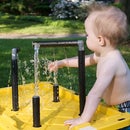Introduction: Water Table, for the Kids
I decided to make a fun water table for my son’s first birthday. He loves water in the sink and the bathtub so instead of getting a boring old tiny pool, I went this route. I wanted fountains and sprayers and a self contained reservoir and pump so it wouldn’t need to be attached to the hose. I got all the goods at a local home-improvement store and got it together in about 2 hours.
Step 1: Materials and Tools
Materials needed:
a plastic storage bin with a cool lid (I got a couple of these in a two-pack)
a 330 gph statuary pump (in the garden pond section)
3/4” x 5’ polyethylene plastic water pipe (the price tag said “3/4” x5’ NSF PE 160PSI STICK (PEP)”)
3/4” insert plug (in the same section as the pipe above)
3/4” 90D elbow insert
3/4” tee insert
3/4” ID vinyl tube (I got a 10’ piece)
and a few simple tools:
a hand saw
a power drill
various drill bits, one a bit bigger than the outer diameter of the pipe and a few smaller ones
a utility knife (or something else to cut the vinyl tubing)
a plastic storage bin with a cool lid (I got a couple of these in a two-pack)
a 330 gph statuary pump (in the garden pond section)
3/4” x 5’ polyethylene plastic water pipe (the price tag said “3/4” x5’ NSF PE 160PSI STICK (PEP)”)
3/4” insert plug (in the same section as the pipe above)
3/4” 90D elbow insert
3/4” tee insert
3/4” ID vinyl tube (I got a 10’ piece)
and a few simple tools:
a hand saw
a power drill
various drill bits, one a bit bigger than the outer diameter of the pipe and a few smaller ones
a utility knife (or something else to cut the vinyl tubing)
Step 2: Drill Some Drainage Holes
Start by drilling drainage holes on the lid of the bin so that any water squirted out of the fountains will not pool on top but drain back into the reservoir. On this cool lid, I put about a 3/8” hole at every intersection of the molded texture, which happens to be the lowest point on the lid.
Step 3: Plumbing Structure
Next cut some 2” lengths of black pipe with your hand saw (or a power miter box saw) and assemble the three tee inserts and four 90D elbow inserts into the main plumbing structure.
I found that it took a bit of force to get the pipe onto the inserts. What helped was soaking the black pipe pieces in really hot water for 30 seconds right before putting them on the inserts. It helps to have a plan of action and a big bowl of hot water.
Step 4: Drill Holes for Fountain Parts
Lay the main plumbing structure on the lid to find the best location for the holes that will allow the vertical fountain pipes to come above the lid. Mark the spots with marker and drill them out with bit a little larger than the diameter of the black pipe.
Step 5: Fountain Parts
Take the remaining black pipe and cut it into six pieces, varying the length a bit. Four of those pieces get an insert plug and the remaining two get a 90D elbow insert, followed by two of the ones that got plugs. You should end up with the four vertical fountain pieces.
Step 6: Drill a Hole for the Power Cord
Drill a hole in the side of the bin, below the rim, for the pump’s power cord to pass through. Then make a vertical cut through the rim to that hole with your hand saw.
Step 7: Get the Pump in the Bin
Pass the power cord through the hole in the bin by cramming it down the cut you made. Place the pump at the bottom of the bin. Attach the plumbing assembly to the top of the pump with a small piece of vinyl tubing.
Step 8: Assembly
This is the tricky part: pass each of the vertical fountain pieces through the holes in the lid and attach them to the plumbing assembly while holding the lid on partially. Close the bin and adjust the positioning of everything so that the fountain parts are roughly vertical.
Step 9: Make Some Holes for the Water to Come Out
Drill small holes in the plug inserts that point up. Small is key here. If you make the holes too big before you test the water pressure, you could end up with not enough water pressure. You can’t re-drill a smaller hole, only a bigger one. So start small.
Drill some holes along the underside of the horizontal fountain pipes. Take it easy with the size and number of them; you can always add more later.
Step 10: Fill It Up and Test It.
Fill the reservoir with enough water to cover the pump by a couple of inches. You can pour or hose water right onto the lid. Plug the pump in to test the water pressure coming out of the fountains. If it’s too much, unplug the pump and increase the size of a hole or two and test it again. Keep this up until you get the perfect pressure for fun.




